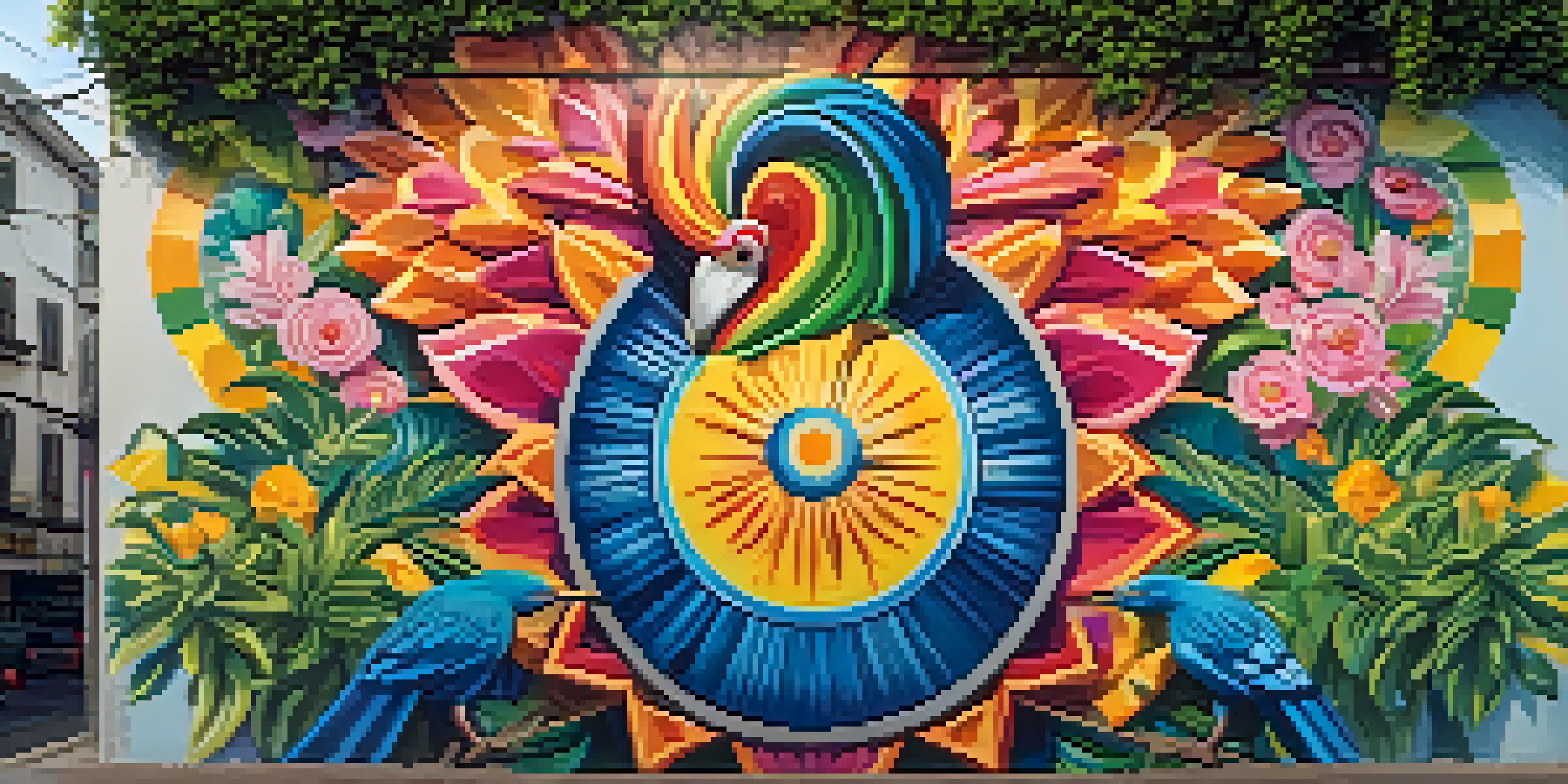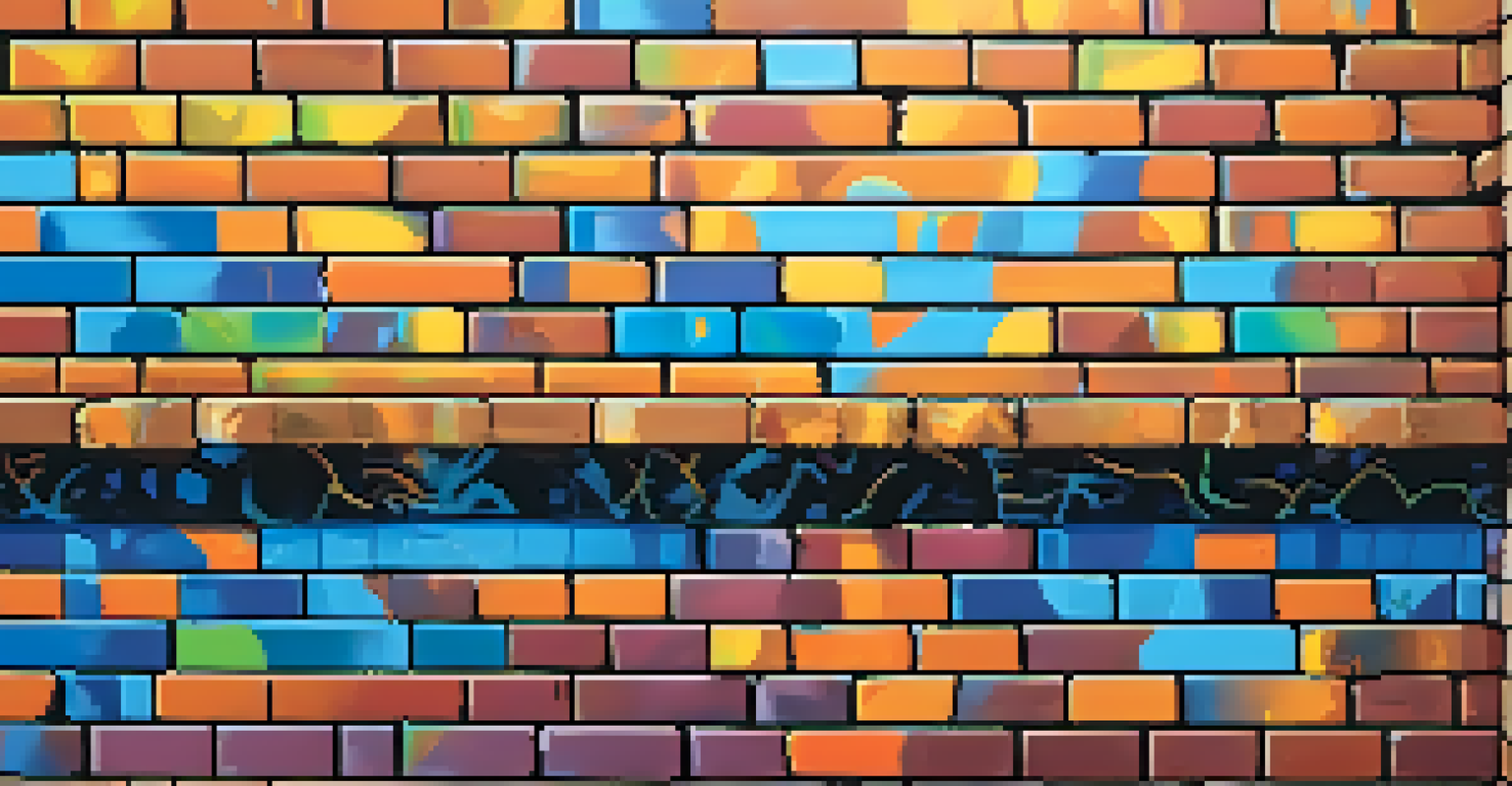Exploring the Roots of Brazilian Street Art: A Cultural Journey

The Origins of Street Art in Brazil
Brazilian street art has deep roots, emerging from a blend of local culture, social issues, and global influences. It began gaining momentum in the 1980s, with artists using public walls as their canvases to express dissent and hope. This creative rebellion was fueled by the country's turbulent history and a desire for freedom of expression.
Art is a way to express oneself and to communicate with others. It can transform a wall into a canvas of stories that reflect the spirit of the community.
One can think of street art in Brazil as a conversation starter that takes place right on the streets. It’s not just about paint on walls; it’s about culture, identity, and community. Artists like Os Gêmeos and Eduardo Kobra have played significant roles in shaping this dialogue, bringing their unique styles to the forefront.
As Brazil transitioned from dictatorship to democracy, street art flourished, reflecting the people's stories and struggles. Each mural tells a tale, often capturing the essence of Brazilian life, from the exuberance of Carnival to the challenges of urban living.
Key Themes in Brazilian Street Art
The themes in Brazilian street art are as diverse as the country's landscape. Common motifs include social justice, environmental issues, and cultural heritage, resonating with both locals and tourists alike. For instance, you might see a mural depicting the Amazon rainforest, highlighting the urgent need for preservation.

Artists often draw inspiration from their surroundings, using their work to address pressing social issues such as inequality and violence. This thematic richness transforms street art into a powerful medium for advocacy and change, making the streets a gallery of activism.
Street Art Reflects Brazilian Culture
Brazilian street art serves as a vibrant expression of local culture, identity, and social issues, turning public spaces into canvases for dialogue.
In addition to activism, Brazilian street art also celebrates cultural identity. Murals often showcase Afro-Brazilian heritage, indigenous traditions, and the vibrant tapestry of life in Brazilian cities, making each piece a celebration of the nation's diversity.
Famous Brazilian Street Artists
When discussing Brazilian street art, names like Os Gêmeos immediately come to mind. This twin duo is renowned for their whimsical characters and vibrant colors, which often convey social messages wrapped in playful imagery. Their work has transcended borders, making them international ambassadors of Brazilian street art.
Street art is a powerful tool for social change, a voice for the voiceless, and a means of reclaiming public spaces for everyone.
Another notable artist is Eduardo Kobra, famous for his large-scale murals that often feature portraits of historic figures or cultural icons. His use of geometric patterns and bright colors creates a visual feast, drawing viewers in while sparking curiosity about the subjects he depicts.
Then there's Titi Freak, whose work merges graffiti with elements of fine art, bringing a unique perspective to the street art scene. His pieces often incorporate Brazilian folklore, creating a visual narrative that connects the past with the present.
The Role of Graffiti in Brazilian Culture
Graffiti in Brazil has evolved into a cultural phenomenon, serving as a voice for the voiceless. It’s a tool for artists to comment on societal issues and to reclaim public spaces that often feel exclusive. In this way, graffiti acts as a democratizing force, inviting everyone to join the conversation.
Consider the walls of São Paulo, where graffiti artists transform dreary urban landscapes into vibrant showcases of creativity. This transformation speaks to the resilience of communities, turning neglected areas into lively hubs of art and culture, which in turn attracts tourism and local pride.
Key Artists Shape the Scene
Renowned artists like Os Gêmeos and Eduardo Kobra have significantly influenced the Brazilian street art movement with their unique styles and social messages.
Moreover, graffiti often acts as a bridge between different social classes. By placing art in public spaces, it becomes accessible to all, making it a shared experience that fosters community connection and dialogue.
Street Art Festivals and Their Impact
Street art festivals in Brazil have become significant events that celebrate creativity and community. Festivals like the 'Festival Internacional de Graffiti' bring together local and international artists, fostering collaboration and cultural exchange. These gatherings not only showcase talent but also attract art enthusiasts from around the globe.
During these festivals, artists have the opportunity to create large-scale murals, often with a collaborative twist. This teamwork leads to a more dynamic and engaging art scene, where different styles and techniques merge, resulting in stunning visuals that reflect the creativity of all involved.
The impact of these festivals extends beyond art; they also stimulate local economies by attracting tourists and promoting local businesses. A vibrant street art scene can revitalize neighborhoods, turning them into must-visit destinations for culture seekers.
The Global Influence of Brazilian Street Art
Brazilian street art has made waves beyond its borders, influencing artists worldwide. The unique blend of styles, techniques, and cultural narratives has inspired many to incorporate Brazilian elements into their own works. This cross-pollination of ideas showcases how art transcends geographical limitations.
Take a look at contemporary street art movements in cities like Berlin or New York; many artists have drawn inspiration from Brazilian techniques, such as vivid color palettes and intricate patterns. This global appreciation highlights the universal language of art and its ability to connect diverse cultures.
Challenges Affecting Street Artists
Despite its popularity, Brazilian street art faces legal restrictions and mixed societal perceptions, prompting artists to advocate for its recognition and acceptance.
Moreover, social media has played a pivotal role in spreading the visibility of Brazilian street art. Artists can share their work with an international audience, fostering a sense of community and collaboration that continues to evolve.
Challenges Faced by Street Artists in Brazil
Despite its vibrancy, Brazilian street art faces several challenges, including legal restrictions and societal perceptions. Many artists operate in a gray area, as not all street art is sanctioned, leading to potential legal repercussions. This precarious situation often forces artists to balance creativity with caution.
Additionally, there are ongoing debates regarding the legitimacy of street art as a form of expression versus vandalism. Public perception can vary significantly, with some viewing it as a nuisance while others celebrate it as an essential part of urban culture. This divide can complicate the lives of street artists.

However, many artists are determined to navigate these challenges, using their platforms to advocate for the acceptance and recognition of street art. This ongoing struggle highlights the importance of dialogue in understanding the value of street art in Brazil’s cultural landscape.